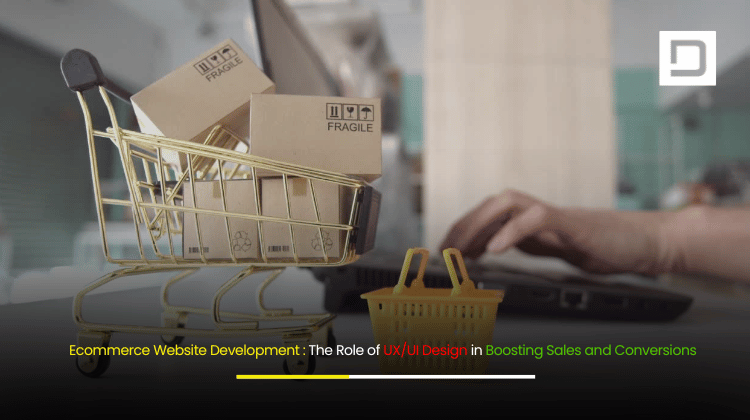Ecommerce Website Development : The Role of UX/UI Design in Boosting Sales and Conversions
In the ever-evolving digital landscape, businesses are constantly striving to enhance their online presence and deliver a seamless shopping experience to their customers. When it comes to ecommerce website development, a critical aspect that directly impacts sales and conversions is the user experience (UX) and user interface (UI) design. As more consumers turn to online shopping, it’s essential for businesses to optimize their ecommerce websites for usability, accessibility, and engagement. This blog will explore the significant role of UX/UI design in driving ecommerce success, focusing on how it can boost sales, improve conversion rates, and enhance customer satisfaction.
The Power of UX/UI Design in Ecommerce Websites
User Experience (UX) refers to how users feel when interacting with a website, while User Interface (UI) design focuses on the aesthetic aspects, such as the layout, colors, fonts, and other elements users engage with. Together, UX and UI design create a functional, visually appealing, and intuitive website that enhances user satisfaction. In ecommerce, where customers make purchasing decisions within minutes, a poor UX/UI design can result in lost sales and abandoned carts.
Effective UX/UI design plays a pivotal role in:
- Reducing Bounce Rates
- Enhancing User Engagement
- Improving Customer Retention
- Boosting Conversion Rates
Let’s delve deeper into the importance of UX/UI design in ecommerce website development and how it can directly affect your business’s success.
1. How UX/UI Design Affects Conversion Rates
Conversion rate optimization (CRO) is the practice of improving the percentage of website visitors who take a desired action, such as making a purchase. UX/UI design is integral to this process, as it influences user behavior and decision-making.
Intuitive Navigation and Clear Calls-to-Action (CTAs)
A website that is easy to navigate encourages users to explore and make purchases. Navigation elements like menus, categories, and search bars should be clearly visible and logically organized. A well-structured site ensures that users don’t get lost or frustrated. For example, products should be easily discoverable, and the shopping cart should be accessible at all times.
In addition to clear navigation, having well-placed CTAs is crucial in guiding users through the sales funnel. Effective CTAs prompt users to take action, whether it’s adding an item to their cart, signing up for a newsletter, or completing the checkout process. Optimizing CTA buttons for visibility and actionability can significantly increase conversion rates.
Reducing Friction During Checkout
The checkout process is often where many ecommerce businesses lose potential customers. A complicated or lengthy checkout process is one of the primary reasons for cart abandonment. By focusing on UX/UI design, you can reduce friction in the checkout process by:
- Minimizing steps: Make the checkout process as streamlined as possible, ideally limiting it to a few easy steps.
- Offering guest checkout: Many users hesitate to create an account, so offering a guest checkout option can help increase conversions.
- Auto-filling fields: Simplify data entry by auto-filling address and payment details, ensuring the process feels quick and easy.
- Providing multiple payment options: Including various payment methods, such as credit cards, PayPal, or digital wallets, can cater to different user preferences and enhance conversion rates.
2. The Visual Impact of UI Design on Sales
The user interface (UI) design involves the visual elements users interact with on a website. Aesthetics and functionality work together to provide a compelling shopping experience. Well-designed ecommerce websites that are visually appealing tend to attract more users and keep them engaged longer.
Brand Identity and Trust
An ecommerce website is a direct reflection of your brand. Consistency in design elements like logos, colors, typography, and imagery helps reinforce brand identity and builds trust. Trust is a significant factor in ecommerce sales—if a website appears unprofessional or outdated, potential customers may feel insecure about making a purchase.
- Color psychology: The use of color in UI design can influence purchasing behavior. For example, the color green is often associated with trust, while red can stimulate urgency. Choose colors wisely to align with your brand and evoke the right emotions in your customers.
- High-quality imagery: Ecommerce websites rely heavily on product images. High-quality images that showcase products from different angles, in context, and with zoom functionality increase user confidence in the product’s quality. Users are more likely to convert if they can visualize how a product will look or fit in their lives.
- Consistency in design: Consistent UI elements, such as buttons, icons, and fonts, ensure that users have a cohesive and familiar experience as they navigate your site. Consistency leads to a smoother interaction and helps users feel more comfortable making a purchase.
Mobile Responsiveness
With the rise of mobile shopping, it’s critical for ecommerce websites to be mobile-friendly. Poorly optimized mobile websites can lead to a frustrating user experience, causing potential customers to abandon the site and seek alternatives.

A responsive design adapts to various screen sizes, ensuring that the UI is visually appealing and functional on both desktop and mobile devices. Mobile-friendly ecommerce websites tend to have higher conversion rates because they cater to the growing number of mobile shoppers.
3. Optimizing Load Speed with UX/UI Design
Website load speed is one of the most important factors influencing user satisfaction and conversion rates. Slow-loading websites increase bounce rates and lower user engagement. According to a study by Google, 53% of mobile users will leave a page that takes longer than three seconds to load.
UX/UI design can directly affect load speed. By optimizing the design and minimizing unnecessary elements, you can create a faster website experience for users. Some tips for improving load speed include:
- Optimizing images: Compress images without sacrificing quality to reduce page load times.
- Minimizing scripts and code: Remove unnecessary scripts, CSS, and JavaScript files that can slow down the website.
- Implementing lazy loading: Load images or elements only when users scroll down, reducing initial page load time.
By focusing on UX/UI design principles that prioritize performance, you can provide a seamless browsing experience and keep customers on your site longer.
4. Enhancing Customer Retention Through Personalization
Personalization is key to retaining customers and encouraging repeat purchases. With the help of UX/UI design, ecommerce websites can offer tailored experiences that resonate with users on a personal level. Personalization strategies include:
Product Recommendations
Using UX/UI design to feature personalized product recommendations based on browsing history, previous purchases, or preferences can encourage users to explore more products and increase their chances of making additional purchases.
Customizable User Experience
Allow users to customize their shopping experience. This could include features like wishlist creation, account preferences, and personalized offers. A tailored shopping experience makes users feel valued, increasing the likelihood of return visits.
5. The Role of UX/UI Design in Building Trust and Reducing Cart Abandonment
Trust is essential in ecommerce. Customers must feel confident that their personal and payment information is secure, and they must trust the website to deliver their products as promised. UX/UI design can help build trust by incorporating elements like:
- Security badges: Displaying SSL certificates and trusted payment options visibly can help users feel safe when entering their payment information.
- Customer reviews and ratings: Displaying product reviews, testimonials, and ratings can help build credibility and encourage purchases.
Reducing cart abandonment can also be achieved through design choices like offering easy access to the shopping cart, providing clear shipping and return policies, and offering real-time customer support via live chat.
Conclusion: Why Choose Depex Technologies for Your Ecommerce Website Development?
UX/UI design is not just about aesthetics—it is a vital aspect of ecommerce website development that directly influences sales, conversions, and customer satisfaction. A well-designed website that provides an intuitive, visually appealing, and personalized shopping experience can make all the difference in driving success.
At Depex Technologies, we specialize in creating customized ecommerce websites with a focus on UX/UI design that maximizes user engagement and drives higher conversions. Whether you’re starting a new online store or looking to optimize your existing website, our team of expert designers and developers will help you build a platform that delivers exceptional results.
Ready to create a top-performing ecommerce website that enhances your customer experience and boosts your sales? Contact Depex Technologies today, and let us help you build an ecommerce website that aligns with your business goals.






